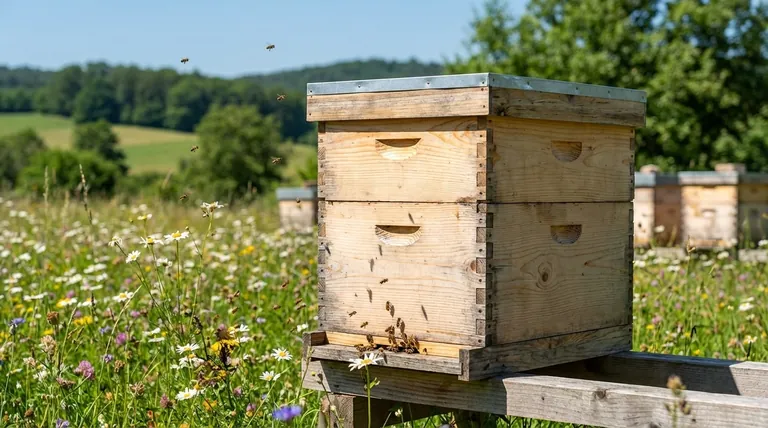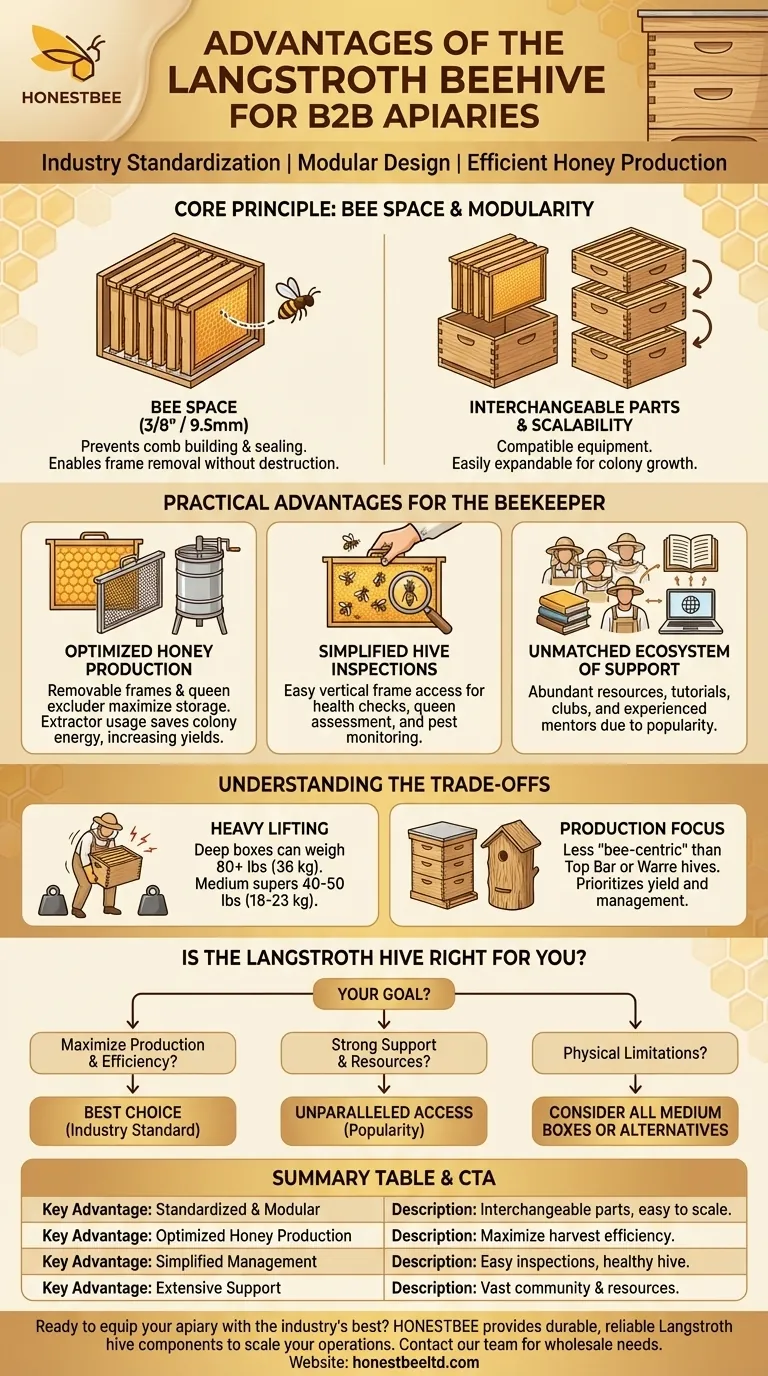The primary advantages of the Langstroth beehive are its industry standardization, modular design that simplifies management, and its efficiency for honey production. Because it is the most common hive in the world, its parts are interchangeable, supplies are readily available, and a vast community of experienced beekeepers exists for support.
The Langstroth hive's true advantage lies not in a single feature, but in its complete, integrated system. Its design, based on the principle of "bee space," created a standardized and scalable hive that revolutionized beekeeping by making hive management and honey harvesting possible without destroying the comb.

The Core Principle: Bee Space and Modularity
The genius of the Langstroth hive is rooted in its foundational design principles, which directly address the practical needs of both the bees and the beekeeper.
Understanding "Bee Space"
The entire system is based on Reverend Lorenzo Langstroth's 1851 discovery of "bee space"—a gap of about 3/8 of an inch (9.5mm).
Bees will leave a space of this size open for passage. If a space is smaller, they will seal it with propolis; if it's larger, they will fill it with honeycomb.
By building a hive with frames precisely spaced apart, Langstroth allowed beekeepers to easily remove and inspect individual frames without angering the bees or destroying the delicate wax comb. This was a revolutionary leap in hive management.
A System of Interchangeable Parts
The Langstroth design became the industry standard, meaning that boxes, frames, covers, and other equipment from different manufacturers are almost always compatible.
This standardization simplifies sourcing equipment and ensures you can easily replace or add components as your apiary grows.
Scalability for Growth
The hive consists of a series of stacked boxes. As a colony expands and needs more space for brood or honey, the beekeeper can simply add another box on top.
This modularity allows the hive to grow or shrink along with the colony's population and nectar flow, making it incredibly adaptable.
Practical Advantages for the Beekeeper
The design of the Langstroth hive translates directly into significant, real-world benefits that have made it the top choice for commercial and hobbyist beekeepers alike.
Optimized for Honey Production
The Langstroth hive is unequivocally favored for honey production. Its removable frames and use of a queen excluder allow the beekeeper to manage the hive for maximum honey storage.
The ability to use an extractor to harvest honey from the frames, which are then returned to the bees, saves the colony immense energy and time, leading to higher yields.
Simplified Hive Inspections
Regular inspections are critical for maintaining a healthy bee colony. The Langstroth's vertical frames make it easy to check on the queen's egg-laying pattern, look for signs of pests or disease, and assess food stores.
This ease of access allows for proactive management that can prevent problems before they threaten the colony's survival.
An Unmatched Ecosystem of Support
Because it is the most common hive type in use, the amount of available support is enormous.
New beekeepers will find an abundance of books, online tutorials, local beekeeping clubs, and experienced mentors who are all familiar with the Langstroth system.
Understanding the Trade-offs
While the Langstroth is dominant, it is essential to understand its potential downsides to make an informed decision.
The Weight of the Boxes
The primary drawback is the weight. A deep hive box filled with brood, pollen, and honey can weigh over 80 lbs (36 kg), and a medium honey super can weigh 40-50 lbs (18-23 kg).
This can present a significant physical challenge, especially for beekeepers with back problems or limited strength.
A Focus on Production
The hive is an instrument of production. Some beekeepers feel its boxy design and management practices are less in tune with a bee's natural inclinations compared to hives like the Top Bar or Warre.
These alternative hives often sacrifice honey yield and ease of inspection for a more "bee-centric" approach.
Is the Langstroth Hive Right for You?
Choosing a hive style depends entirely on your personal goals as a beekeeper.
- If your primary focus is maximizing honey production and operational efficiency: The Langstroth is the undisputed industry standard and the best choice for this goal.
- If you are a new beekeeper seeking strong community and readily available resources: The Langstroth's popularity provides unparalleled access to mentors, equipment, and educational materials.
- If you have physical limitations or are concerned about heavy lifting: You should plan to use all medium-sized boxes for a more manageable weight or explore alternative hive designs.
Ultimately, the Langstroth hive's enduring popularity is a testament to its brilliant design, which empowers beekeepers to manage their colonies effectively and productively.
Summary Table:
| Key Advantage | Description |
|---|---|
| Standardized & Modular | Interchangeable parts from any manufacturer; easy to source and scale. |
| Optimized Honey Production | Removable frames and queen excluder maximize honey harvest efficiency. |
| Simplified Hive Management | Easy inspections for health checks without destroying comb. |
| Extensive Support Network | Vast community of experienced beekeepers and abundant resources. |
Ready to equip your apiary with the industry's best?
As a leading wholesale supplier to commercial apiaries and equipment distributors, HONESTBEE provides the durable, reliable Langstroth hive components you need to scale your operations and maximize honey production. Our bulk-focused offerings ensure you get the right equipment at the right price.
Contact our team today to discuss your wholesale needs and see how we can support your beekeeping success.
Visual Guide

Related Products
- Telescopic Beehive Outer Cover Lid Roof with Galvanised Sheeting for Langstroth Hive and Beehive Outer Cover
- Stainless Steel 9 Frame Hive Spacer Durable Precise for Commercial Beekeeping
- Ergonomic Two Person Foldable Hive Lifter
- Professional Galvanized Hive Strap with Secure Locking Buckle for Beekeeping
- Professional Insulated Winter Hive Wrap for Beekeeping
People Also Ask
- How do you install the Langstroth hive roof? A Step-by-Step Guide for a Healthy Colony
- Can bees enter from both sides of the outer cover? Master Seasonal Hive Management
- What is the purpose of the inner and outer covers in a beehive? Essential for Hive Health & Management
- What is the function of the top cover in a Langstroth hive? Master Hive Protection & Climate Control
- What are the features of the peaked roof in Langstroth hives? Superior Weather Protection & Stability



















